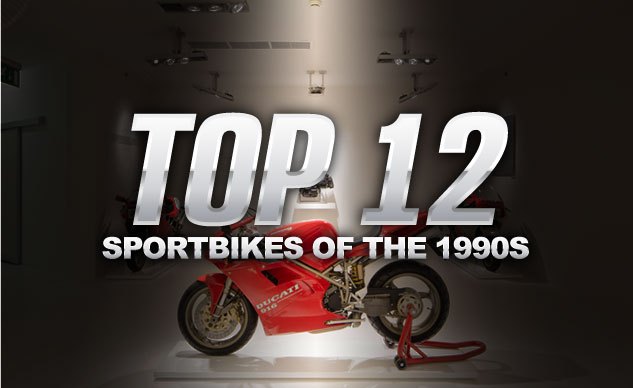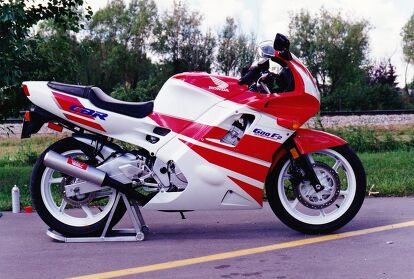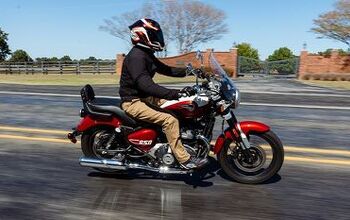Top 12 Sportbikes of the 1990s
When motorcycles were fat and we were skinny
Hey, I’m sorry it’s always about me, but the 1990s really were: In the ’90s, I got a new wife, a new child, a condo, a new truck! And the motorcycle manufacturers pampered me (and all the rest of us tail-end Boomers) with a lot of great new jockey shorts-dropping sportbikes that many of us could actually afford to buy. Later, as Bill Murray famously said in Stripes, “reality set in.” But the ’90s were great while they lasted. These, listed chronologically, are the bikes we, the whole MO staff (even Troy, who was but a wee pup), remember most…
1990 Kawasaki ZX-11
In my formative years at Cycle magazine, I went on a “comparison test” ride with Ken Vreeke and Thad Wolff and some other characters on a ZX-11, a GSX-R1100, an FZR1000 and a CBR1000F. I couldn’t keep up with any of those guys in the really curvy stuff, but on California 166 there are some pretty decent straights that separate its miles of fast, smooth sweepers. On the ZX-11 on that road, Vreeke later wrote something like: “When I looked in my mirror there was the ZX-11, a black malevolence expectorated from the lungs of Satan himself.” Haha! That was me riding it!
Now there are plenty of bikes that can go 170, but in 1990 there was only one, and the aerodynamic, ram-air fed 1052cc ZX-11 was it. Kawasaki called on its bullet-train building experience in designing the thing. It was over-the-top ridiculous, but it was (and probably still is) a great sport-tourer. All of us had a hard time keeping our drivers licenses in those days; thank God we’ve matured.
1991 Honda CBR600F2
The original Hurricane blew our socks off in 1987, but when F became F2 in 1991, Honda’s plastic-covered middleweight morphed into one of the best all-rounders of all time – a near-perfectly balanced sportbike that won all the shootouts as well as the ’91 AMA 600 Supersport title under Miguel Duhamel. A better companion than your dog, it was also happy to be ridden on a daily basis or to San Francisco for the weekend, and it was so well regarded it enticed Ed-in-Cheese Duke to buy a new one and take it club racing – that’s his old bike in the picture here. At the time, it was a “sportbike”; today we’d have to invent a new category, probably the “plastic-covered standard.” All yours for $4,998.
1992 Honda CBR900RR
If you wonder how sportbikes got on the lighter, faster, more specialized path they’ve been on for the last 25 years, look no further than the original “Fireblade” (not that it was ever called that in the U.S.). Open-classers at the time were the FZR1000, GSX-R1100, ZX-11 and Honda’s own CBR1000F – all of them more than powerful enough but also quite large. Mr. Baba’s baby wasn’t much bigger than a typical 600; in fact it was a mere two pounds more than the F2 – but more than 100 pounds lighter than a GSX-R1100. And if its 893cc straight-Four didn’t make quite the power of the bigger engines, the CBR’s unprecedented power-to-weight ratio more than made up for it. It also pointed out the fact that a little more trail than 89mm, a 17-inch front wheel instead of the 16-incher the CBR came with, and a stronger fork wouldn’t have been bad things, all of which would have to wait til later. Could be why you don’t see many of these around anymore.
1994 Ducati 916
The 851 was lovely, the 888 was delicioso – but when they rolled the new 916 off the elevator onto the 17th floor of Petersen Publishing it knocked our eyeballs out. I must’ve seen photos of it before then, but this thing was like meeting Cleopatra in person, complete with asp. That body, those underseat exhausts, those headlights… suddenly it became clear that Ducati was no longer content to be an exotic motorcycle boutique. Like the Honda 900RR, it wasn’t the most powerful thing out there, but its lightness and stability (unlike the RR), along with its heavy bass rhythm, stoked the rider’s confidence. It started right in winning the next four out of five World Superbike championships under Carl Fogarty and Troy Bayliss, eventually forcing Honda to build the RC51 to dislodge it. (Full props to John Kocinski for breaking up the Ducati party by winning on a 750cc RC45 in 1997.)
1994 Honda VFR750F
Honda had been cranking out 750 V-Fours since 1983, to lesser or greater effect: This ’94 (thru ’97) might be the greatest, the last generation before the 750 became the fuel-injected VFR800 in ’98, gaining weight and complexity. The ’94 still had carburetors feeding its V-Four, with gear-driven cams that gave the thing a cool whirring noise that went well with the NACA ducts in the sides to give a Starship Enterprise effect. Which made sense, really, since this one almost didn’t make the list by dint of being more sport-tourer than sportbike, a great traveler in classic Honda big-umbrella style. The VFR wasn’t as fast as the other bikes here around a closed circuit, but it was a magical-handling one on the road, with a perfect balance of velvety smooth power, comfort and control. Honda’s RC30 is high on the collectible list; the VFR750F was the poor man’s version, sharing identical bore-and-stroke numbers in its engine (no Ti connecting rods, sorry), single-sided swingarm, and other bits.
1996 Suzuki GSX-R750
More than just rad, this thing was SRAD – Suzuki Ram Air Direct. But it was rad, too, a radical departure from the pre-existing GSX-R condition, which was by then heavy and slow. Playing the Schwantz card, the geometry of the new twin-spar frame was said to emulate the RG500 GP bike, with an all-new light and compact 13,500-rpm inline Four housed inside. Relatively inexpensive and bullet-resistant, this one may have been too little too late, as the other manufacturers had already seen the writing on the wall: Kawasaki, Honda and Yamaha had mostly given up on further development of their 750s as they sought something capable of keeping up with the Ducati; by 2003, Superbike racing around the world was letting 1000cc Fours into the mix. None of that takes away from Mat Mladin’s three AMA Superbike championships on the 750, 1999 through 2001, and none of it takes away from the fact that the current GSX-R750 is still the 750 to have. Because it’s the only one you can have.
MO’s original test, by Andy Saunders, is here.
1997 Triumph Speed Triple
The ’93 Ducati Monster usually gets credit for being the first modern “naked” bike, but the second-generation T509 Speed Triple was really the one that set our little hearts all atwitter, launching a new Beatlemania for the not-quite middle-aged motorcycle male. The big chrome headlights stirred up a little Quadrophenia, the outlandish colors (Roulette Green here) were pure punk, single-sided swingarms were exclusive, and the torquey/raspy 885cc Triple just seemed to encourage bad behavior: With no expensive bodywork to shred, what’s the worst that could happen? Slightly sanitized and much more sophisticated, the current Speed Triple remains a favorite today.
1998 Aprilia RSV Mille
Apriliwho? Don’t they make scooters and little two-strokes for Euroweenies? Why yes they do, and suddenly they also make an exotic V-Twin literbike that acts like it wants to go head-to-head with another certain Italian manufacturer. The “R” version, pictured, was even more exotic, with its Öhlins suspension, OZ forged wheels and single-seat subframe. A 998cc 60-degree V-Twin from Rotax provided contemporary horsepower while being compact enough to let the Mille handle with the best of them. All in all, a beautiful debut from a company that’s been building some of MO’s very favorite sportbikes ever since.
Here’s me going off in a 2003 comparo re: that year’s Mille. And here’s Gabe going off about the 2005 model.
1998 Yamaha YZF-R1
Yamaha’s carefully considered response to the CBR900RR took a while getting here, but when it did it achieved immediate supremacy via 150 claimed crankshaft horsepower from its 20-valve inline-Four and a great reduction in mass from the previous YZF1000R. At the same time, a huge increase in overall compactness resulted from fresh thinking including stacking the transmission input and output shafts, and the original R1’s sleek, predatory bodywork and beautiful brushed alloy frame make it one of the prettiest Japanese sportbikes of all time in many eyes. This one really ushered in the current era of full-on 1000cc pure sportbikes, an arms escalation that continues today.
Our take on the last of the first-gen R1s, the 2000 R1, is here.
1999 Suzuki SV650
Suzuki’s response to the Ducati Monster was one of the friendliest, most accessible motorcycles of the decade. The original SV used an exotic oval-section aluminum tube frame inspired by OVER Racing in Japan. Apart from that, there was nothing terribly trick about the SV except for its exhaust note; if you squinted your ears its 645cc V-Twin sounded just like a Ducati coming down the road, and it delivered power like one, too. That throbbing midrange, in fact, was what made it such a hit. Some have argued that the SV did more to boost Ducati sales than any Ducati ever did. It also did a lot to get lots of new racers on the track, thanks to its great handling and unintimidating demeanor.
I wonder who wrote MO’s first SV650 review anyway? So avant garde, so out of left field, so MOronic…
1999 Suzuki GSX1300R Hayabusa
The wind-tunnel-shaped ’Busa was Suzuki’s moon shot dedication to speed, instantly becoming the fastest motorcycle the world had ever seen and made everyone forget about ZX-11s and Blackbirds. Not only was the Hayabusa a hoot to spin laps upon around Circuit Catalunya during its launch, I’m pretty sure it’s the only bike I’ve ever almost gotten a knee down on the freeway. Period tests showed it could make the quarter-mile sprint in less than 10 seconds and accelerate past 190 mph. And when hints of 200-mph motorcycles started making the rounds in the general public, the ‘Busa was the primary reason a 300-kph (186 mph) speed limiter was gentlemanly agreed-upon among manufacturers.
Kawasaki’s H2R might be faster now, but Suzuki’s omnivorous fowl is still in production and remains the world’s fastest production bike you can buy for $14,599, your personal bullet train. One hundred-seventy-three horsepower or so at the rear tire is what the current 1340cc fuel-injected inline Four puts out, which was Suzuki’s crankshaft claim for the original 1299cc engine. Seems like plenty.
1999 Yamaha YZF-R6
This high-winding yet smooth-running inline-Four took up where the CBR600 tailed off. The CBR600F4 released the same year might’ve been a better all-rounder, but the R6 was lighter, wilder and racier, making it the new lust object for aficionados of hardcore middleweight sportbikes. And even though it was the quickest 600 around a racetrack, it was also a fantabulous sportbike you could ride every dang day. MO wadded one spectacularly at the Phillip Island coming-out party, off the super-high-speed Turn 1.
More by John Burns
























































Comments
Join the conversation
Over all I'd have to say these bikes are better looking then anything today. Swoopy, clean, no gratuitous, random, irregular, useless slabs of flat black plastic scattered around. And look! They have actual functioning fenders! Some even have, gasp, choke, centerstands! And gas tanks usually of five gals. with a cruising range far exceeding the 100 miles before the low fuel light comes on like today's bikes. And this retrograde de-evolution is the bike rags fault. Got to have something to sell mags. Hype sells.
Ha ha, I dig that SV650 review. "Just ride it." I wonder who wrote it. Who had a high-speed debacle in Arizona in early 1999 or late 1998?